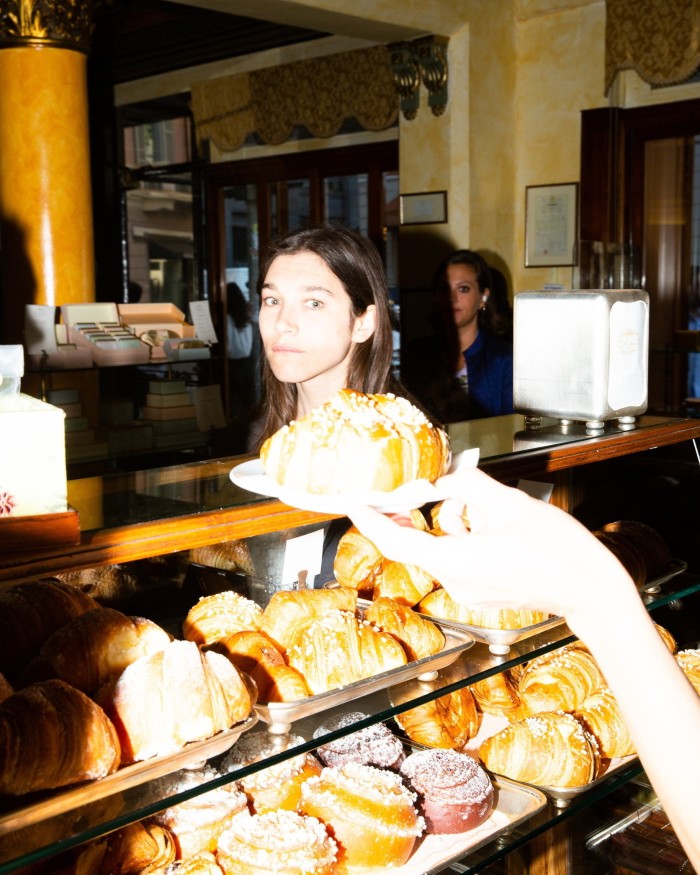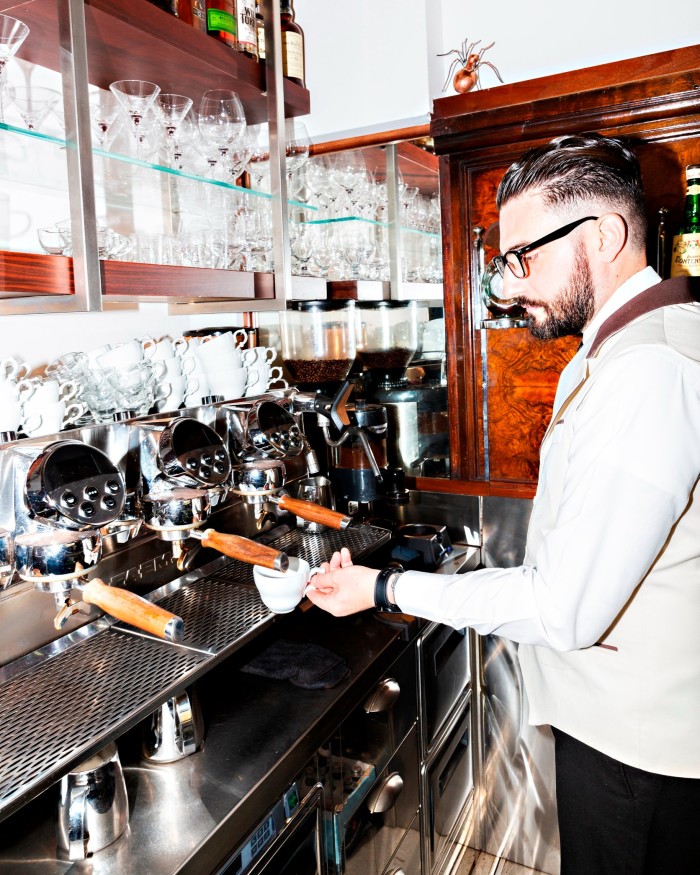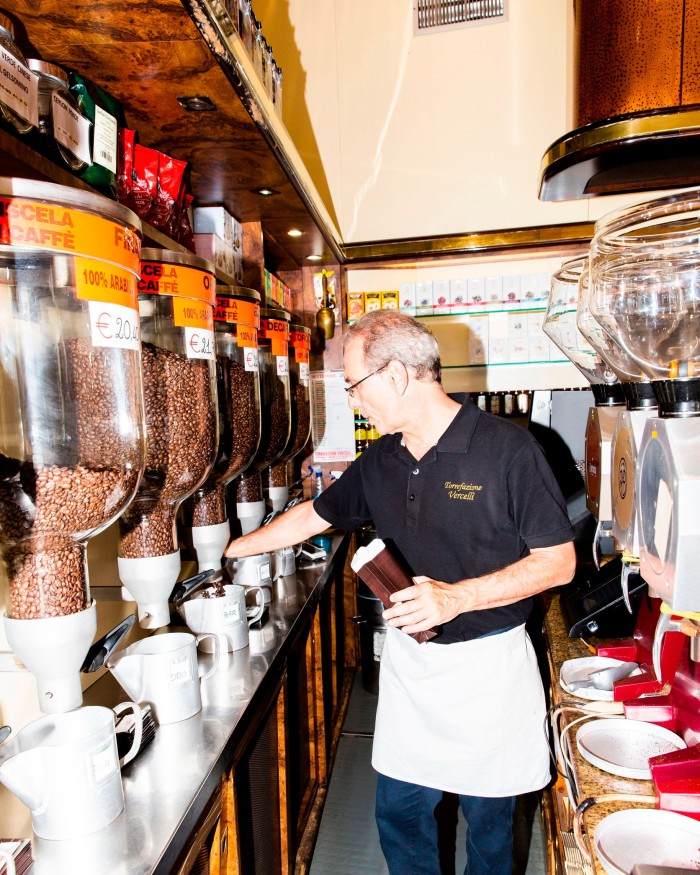This article is part of a new guide to Milan from FT Globetrotter
Milan has a long history with coffee. Locals first discovered it in the 1600s, thanks to the city’s trade with Venice, which imported coffee beans from places including Ethiopia, the Middle East and the Ottoman Empire. Back in the day, the general public used to sip their coffee, sold from pushcarts, on the streets, which was known as caffè del ginoeucc, local slang for “knee” (possibly because the carts barely came to knee-height). The early versions of today’s cafés were reserved for intellectuals and high society.
Fast forward a few centuries, and though the way it is consumed has clearly evolved, Milan’s love for coffee is unchanged, and it remains something between a social occasion and a ritual.
As most readers will know, Italians love their coffee. According to a 2016 report, 97 per cent of the population have at least one coffee per day, while another study published this year shows the average intake is four to five espressos a day per person. The first one tends be drunk at home upon waking, and the second coffee is enjoyed mid-morning, often at the “bar” (a café). After lunch, coffee is a must; some might be amazed to see the speed at which queues form in cafés around Milan’s city centre, as customers rush in for their espresso shot before returning to the office. A final espresso is typically enjoyed in the afternoon, while diehards take their last after dinner.

The studies show most people will add sugar to their espresso; many women prefer to add milk to make it macchiato, while men tend not to — almost all will consume it standing at the counter. And, according to Italian coffee-drinking etiquette, teaspoons should never be licked after stirring.
Morning and afternoon coffees while socialising are slightly different: not as fast-paced, and if seating is an option at the venue, it’s often welcomed by customers who might have a croissant and a cappuccino in the morning, or a few pasticcini to go with their coffee in the afternoon. (NB: an Italian would never order a cappuccino after noon, especially not with a meal.)
As for me, I drink more than four espressos per day, no sugar, no milk. And a disclaimer: I am a real coffee snob. Not once in the 18 years I spent living abroad did I buy a takeaway coffee at a global coffee chain, and I have a hard time downing Nespresso too. I own multiple Moka pots, I only buy my ground coffee in certain shops and, no matter where I was living in the world, I always had coffee from Italy with me. So in my recommendations below, what you won’t find are the places that sell cheap filtered coffee and its variations; nor those that are popular with tourists who generally won’t go for an unsweetened espresso shot. Clearly, it is not an exhaustive list, nor is it based on any specific criteria, but these are the places to which I, as a coffee enthusiast, keep returning, and where I tend to take friends and visitors.
Torrefazione Ernani
Corso Buenos Aires 20, 20124 Milan
-
Good for: Trying different blends and buying freshly ground coffee
-
Not so good for: Sitting down during the winter (it only has a small outside seating space)
-
FYI: No seating space inside
-
Opening hours: Monday–Friday, 7am–7.30pm; Saturday–Sunday, 8am–7.30pm

This historic coffee shop, formerly known as Caffè Ambrosiano before being sold to its current owners, still maintains its traditional Milano feel, with its wooden counter and old-school decor. For years, coffee roasting hasn’t been allowed at the premises following regulatory changes, but the beans are delivered fresh every Tuesday and Friday from Eranani’s factory in Desio, a town north of the city.
Its Blue Diamond coffee made from higher-quality arabica beans won a gold medal last year from the International Institute of Coffee Tasters. The baristas, who greet the many daily regulars by name, rotate the bean mix in the coffee machine with the multiple varieties they also have on sale: customers will always find one of the aromatic arabica coffees readily available, and another that mixes in strong, full-bodied robusta.


The fluffy croissants are excellent breakfast options, and Fabio Arapi, the manager, who previously worked in London, has also added dried fruits, candy jars and nuts to the offering, which he says can be paired with the coffees.
“In London, we’d fill large cups that customers would take away and sip throughout the day,” he says, drinking his coffee with milk, which looks unusually long by Italian standards. “It’s a totally different coffee culture . . . if you are going to sip coffee while you work all day, obviously it can’t be a shot, and if you are going to have a quick coffee at the counter it can’t take hours to drink.”
Arapi and his young, friendly colleagues are a pleasant contrast to the older decor style. Customers, most of whom are locals, are polite but quiet; the younger ones seem to enjoy hanging out to chat with the staff for longer than the length of an espresso.
Pavé
Via Felice Casati 27, 20124 Milan
-
Good for: Relaxed breakfasts and weekend brunches
-
Not so good for: An older crowd looking for a quiet spot
-
FYI: No reservations; expect to queue at weekends
-
Opening times: Wednesday–Monday, 8am–7pm

Pavé was an instant hit when it opened its doors in 2012: it has since expanded its business to running a craft-beer bar across the street, another coffee shop and two gelaterias in the city.
It is the newest café on this list and also the most popular with a younger crowd. If you pop by on a weekday, you will find the room and tables on the pavement outside filled with a young, international and diverse clientele. Not many linger for too long, but very few have their coffee and bakery products standing at the counter. Luca Robotti, who has managed the Pavé shops since 2013, says they’d rather welcome “one more person than a laptop”. While there isn’t a no-laptop policy, the preference is also specified in the menu, so you’re unlikely to find people working at a table for hours on end. But it’s not meant to be a brisk experience either. The mood is chirpy and energetic, with groups of friends, young artsy types and students filling the room with chatter and laughter.

Baristas serve a variety of cappuccinos, macchiatos, freshly made filtered coffees, americanos (which in Italy are an espresso shot served in a larger cup with hot water on the side) and, of course, espressos.
Pavé’s ground coffee, Moka Republic, is also available for sale (as is homemade bread) and it’s 100 per cent arabica beans. For filtered coffee, Pavé partners with different coffee-makers from around the province of Lombardy on a monthly basis.


Don’t miss its baked goods, especially the croissants, which are made daily on site (and the open design allows customers a view of the bakery). La Rossa (The Red), a croissant filled with raspberry custard, and the new peanut and strawberry-grape croissant are popular choices. From the wide variety of cakes on offer, the Tonka, a sponge cake with a pistachio and raspberry-jam filling that’s covered with a white-chocolate mousse infused with tonka beans, is a staple.
Marchesi 1824
Via Santa Maria alla Porta 11/a, 20123 milan
-
Good for: Coffee, cakes and panettone
-
Not so good for: A time-limited customer — they’re always very busy here
-
FYI: This is the original Marchesi location; there are now two others in the city centre, and one in Mayfair (on Mount Street) in London
-
Opening times: Monday–Saturday, 7.30am–8pm; Sunday, 8.30am–8pm


For more than a century, this café has been one of the busiest places off the bustling Corso Magenta from September to May (the city empties for the summer at the end of the school year in early June). Paolo Catanese, the manager, says it’s a place where one can mark the passing of time, pointing to the cake menu that changes seasonally, with many made to celebrate special occasions such as Christmas or Mother’s Day.
Regular customers keep returning for the excellent coffee and cappuccinos too, usually enjoyed with breakfast, or a quick espresso shot mid-morning or after lunch. The Magenta neighbourhood where it’s located is populated by office workers and wealthy local residents, many popping in for the café’s Milano Heritage Blend, a bespoke mix of 70 per cent arabica and 30 per cent specially treated robusta beans, expertly ground by the elegantly dressed baristas.

Usually, coffee is drunk at the counter after standing in the queue for a few minutes, but there is also seating at the back.
Traditionally, Marchesi was famous for its panettone, and locals would queue in the weeks before Christmas to make sure they could secure at least one. It remains one of few venues to sell it year round; a summer variation is made with dried apricots, and the autumn panettone features a marron glacé filling.


Catanese says the café hasn’t changed much since the Prada Group bought it in 2014 — a deal that marked the Milanese fashion house’s debut in the food and drink sector. Angelo Marchesi, a descendent of the original founder, who had spent the better part of his life inside his eponymous café and pâtisserie, advised his children to take a different career route and agreed to sell to Prada because he wanted to keep the ownership local.
Taveggia 1909
Via Uberto Visconti di Modrone 2, 20122 Milan
-
Good for: Pâtisserie and afternoon tea
-
Not so good for: A young crowd looking for a laidback place to relax
-
FYI: The new owners have expanded their offering to add a bistro service and aperitivi
-
Opening times: Monday–Saturday, 7am–8.30pm; Sunday, 7am–3pm
This establishment, which has been renamed Taveggia-Gamberini following a change of ownership (although it continues to be known by its former name), reopened its doors last year after a three-year shutdown.
It followed the bankruptcy of its previous owners and a two-year renovation, which left the ground-floor tea room untouched but added a new bistro area, with a newer design and garden walls, in the basement.

Manager Simona Benetti says the tea room still features its original wood panels and its precious 1930s crystal chandelier. The room’s decor hasn’t changed for more than 70 years, since its last makeover in the 1950s, including its marble floors, olive-green velvet chairs and white tablecloths. A stark contrast to the new bistro space downstairs.
In the tea room, customers linger for slow-paced croissant and cappuccino breakfasts as they read the paper (several Italian dailies are available for customers on the counter at the entrance) or afternoon tea, where the traditional sweet and savoury bites are accompanied by tea, coffee and, for younger customers or tourists, cappuccinos.


Benetti says that after the initial scepticism when the venue reopened in 2022, old customers began flocking back: “People weren’t sure the new one was going to be any better, but eventually things changed.”
The new owners are three women, two of whom are pastry chefs, who also have a historic café-pâtisserie in Bologna called Gamberini, and another in Florence. “That’s why we’ve rebranded but obviously there was no way on earth we could drop the name Taveggia – it is such an institution,” says Benetti.
Though the venue’s new iteration has expanded its offering and service and is now also promoting a few themed evenings, most customers still visit for the coffee, which is bought from 100-year-old Bologna importers and roasters Filicori Zecchini. The variety used for espressos and cappuccinos, the most in-demand coffees here, is made from 90 per cent arabica and 10 per cent robusta beans. Marocchinos (macchiatos with added chocolate) are also popular lately, the barista I spoke to told me.
Torrefazione Vercelli
Via Francesco Cherubini 2, 20145 Milan
-
Good for: Having a truly local coffee experience
-
Not so good for: Decor
-
FYI: No seating available
-
Opening times: Monday–Saturday, 6.30am–7.30pm


This 70-year-old family-owned café was originally a roasting establishment (it still has a large 1950s manual roasting machine at the entrance). The owners still have permits to roast on site (only outside opening hours for safety reasons), but the activity has now shifted to a lab in Trezzano sul Naviglio, a comune to the south-west of the city. (Most historic torrefazioni (coffee roasters), such as this one, moved to industrial areas outside the city as volumes grew, processes were automated and regulations changed.)
Co-owner and manager Stefano Maga still heads out to Trezzano sul Naviglio to take care of the roasting process personally, using an old-school manual machine to do the job. “I love it, it relaxes me, I don’t want one of those automatic ones. I love being in the lab more than here [at the café] as a salesman,” he says, showing me how the old machine at the entrance operates.


Coffee, mainly arabica, is brought in from their lab three or four times a week. A robusta option is also available, as Maga says they want to offer a less expensive alternative to arabica. But he isn’t a fan of robusta beans in general because they have “three times the fat and twice as much caffeine compared to arabica”. (He says that’s the reason certain coffees can be hard to digest.)
Coffee here is served over the counter. Customer favourites include espresso shots with a few variations, such as the caffè freddo, or cold coffee, especially during the warmer months. Not to be mistaken for iced coffee or coffee granita, it is a lightly sugared espresso that is kept in the fridge – a drink usually found more in homes than in cafés.
An avid coffee drinker, Maga has cut his personal consumption from six to three espressos a day. Habits have changed, he says, and filtered is becoming increasingly popular. As is sitting down for a chat over coffee, “while we’ve always operated on an over-the-counter basis”. Despite changing fashions, on Saturday mornings the queue to grab a quick coffee at this historic neighbourhood café extends to the pavement outside.
Best of the rest
As well as the recommendations above, there are many other spots across Milan that are also worth trying, such as Gattullo, Pasticceria Cucchi, Sant’Ambroeus, Bar Magenta, Cova and the Italo-Brazilian Cafezal, to name but a few.
Where’s your favourite spot for a coffee in Milan? Tell us in the comments below. And follow FT Globetrotter on Instagram at @FTGlobetrotter
Cities with the FT

FT Globetrotter, our insider guides to some of the world’s greatest cities, offers expert advice on eating and drinking, exercise, art and culture — and much more
Find us in Milan, London, Tokyo, New York, Paris, Rome, Frankfurt, Singapore, Hong Kong, Miami, Toronto, Madrid, Melbourne, Copenhagen and Zürich
Stay connected with us on social media platform for instant update click here to join our Twitter, & Facebook
We are now on Telegram. Click here to join our channel (@TechiUpdate) and stay updated with the latest Technology headlines.
For all the latest Travel News Click Here

